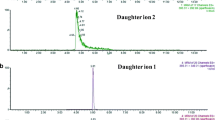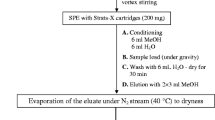Abstract
A method for simultaneously determining the levels of aniline, benzidine, microcystin variants (microcystin-LR, RR, and YR) and carbaryl in water was developed based on ultra-performance liquid chromatography–electrospray ionization tandem mass spectrometry (UPLC-MS/MS). The chromatographic conditions were optimized for the trace determination. Without sample enrichment, the method detection limit for all test compounds ranged from 0.040 to 0.155 μg/L; meanwhile, the recoveries for all test compounds were 83.1–114%. Precision, indicated by the relative standard deviation, was <12.9%. The results meet the requirements for the determination of these compounds. Without the need to clean up the samples, the results of the analysis of samples from wastewater and surface water demonstrated that the UPLC-MS/MS method has the capability to analyze complex matrices in the trace-level monitoring of wastewater samples.





Similar content being viewed by others
References
Bouzige, M., Legeay, P., Pichon, V., & Hennion, M. C. (1999). Selective on-line immunoextraction coupled to liquid chromatography for the trace determination of benzidine, congeners and related azo dyes in surface water and industrial effluents. Journal of Chromatography. A, 846, 317–329.
Cong, L., Huang, B., Chen, Q., Lu, B., Zhang, J., & Ren, Y. (2006). Determination of trace amount of microcystins in water samples using liquid chromatography coupled with triple quadrupole mass spectrometry. Analytica Chimica Acta, 569, 157–168.
Dai, R., Wang, P., Jia, P., Zhang, Y., Chu, X., & Wang, Y. (2016). A review on factors affecting microcystins production by algae in aquatic environments. World Journal of Microbiology & Biotechnology, 32, 51.
Dawson, R. M. (1998). The toxicology of microcystins. Toxicon, 36, 953–962.
European Commission. (2003). Scientific Committee on Toxicity, Ecotoxicity and the Environment (CSTEE) Opinion on the results of the Risk Assessment of: Aniline Environmental part (pp. 2–5).
Harden, J., Donaldson, F. P., & Nyman, M. C. (2005). Concentrations and distribution of 3,3′-dichlorobenzidine and its congeners in environmental samples from Lake Macatawa. Chemosphere, 58, 767–777.
Huang, Z., et al. (2009). Simultaneous determination of 103 pesticide residues in tea samples by LC‐MS/MS. Journal of Separation Science, 32, 1294–1301.
Lacorte, S., Perrot, M., Fraisse, D., & Barcelo, D. (1999). Determination of chlorobenzidines in industrial effluent by solid-phase extraction and liquid chromatography with electrochemical and mass spectrometric detection. Journal of Chromatography. A, 833, 181–194.
Larger, P. J., Breda, M., Fraier, D., & Hughes, H. (2005). Ion-suppression effects in liquid chromatography-tandem mass spectrometry due to a formulation agent, a case study in drug discovery bioanalysis. Journal of Pharmaceutical & Biomedical Analysis, 39, 206–216.
Li, W., Duan, J., Niu, C., Qiang, N., & Mulcahy, D. (2011). Determination of microcystin-LR in drinking water using UPLC tandem mass spectrometry-matrix effects and measurement. Journal of Chromatographic Science, 49, 665–670.
Lizier, T. M., Zanoni, T. B., Oliveira, D. P., & Zanoni, M. V. B. (2012). Electrochemical reduction as a powerful tool to highlight the possible formation of by-products more toxic than Sudan III dye. International Journal of Electrochemical Science, 7, 7784–7796.
Luo, B., Qian, S., Xie, Z., Yao, H., Xiong, J., & Zhao, H. (2015). Simultaneous determination of 13 organic pollutants in water samples by high performance liquid chromatography-tandem mass spectrometry. Chinese Journal of Chromatography, 33, 740–745.
Maizels, M., & Budde, W. L. (2004). A LC/MS method for the determination of cyanobacteria toxins in water. Analytical Chemistry, 76, 1342–1351.
Marco, M. P., Chiron, S., Gascón, J., Hammock, B. D., & Barceló, D. (1995). Validation of two immunoassay methods for environmental monitoring of carbaryl and 1-naphthol in ground water samples. Analytica Chimica Acta, 311, 319–329.
Nogueira, J. M. F., Sandra, T., & Sandra, P. (2004). Multiresidue screening of neutral pesticides in water samples by high performance liquid chromatography–electrospray mass spectrometry. Analytica Chimica Acta, 505, 209–215.
Pérez, S., & Aga, D. S. (2005). Recent advances in the sample preparation, liquid chromatography tandem mass spectrometric analysis and environmental fate of microcystins in water. Trac Trends in Analytical Chemistry, 24, 658–670.
Ruangyuttikarn, W., Miksik, I., Pekkoh, J., Peerapornpisal, Y., & Deyl, Z. (2004). Reversed-phase liquid chromatographic-mass spectrometric determination of microcystin-LR in cyanobacteria blooms under alkaline conditions. Journal of Chromatography B, 800, 315–319.
Słomkiewicz, P. M., Szczepanik, B., & Garnuszek, M. (2015). Determination of adsorption isotherms of aniline and 4-chloroaniline on halloysite adsorbent by inverse liquid chromatography. Applied Clay Science, 114, 221–228.
Tange, S., Fujimoto, N., Uramaru, N., Wong, F. F., Sugihara, K., Ohta, S., & Kitamura, S. (2016). In vitro metabolism of methiocarb and carbaryl in rats, and its effect on their estrogenic and antiandrogenic activities. Environmental Toxicology and Pharmacology, 41, 289–297.
Tribalat, L., Paisse, O., Dessalces, G., & Grenierloustalot, M. (2006). Advantages of LC-MS-MS compared to LC-MS for the determination of nitrofuran residues in honey. Analytical and Bioanalytical Chemistry, 386, 2161–2168.
USEPA (United States Environmental Protection Agency). (1992). Determination of benzidines and nitrogen-containing pesticides in water by liquid-liquid extraction or liquid-solid extraction and reverse phase high performance liquid chromatography/particle beam/mass spectrometry. Cincinnati: EPA Method 553, United States Government Printing Office.
USEPA (United States Environmental Protection Agency) (1996) Aniline and selected derivatives by gas chromatography. EPA Method 8131, United States Government Printing Office.
USEPA (United States Environmental Protection Agency) (1999) Definition and procedures for the determination of the method detection limit. Guidelines establishing test procedures for the analysis of pollutants-appendix B, part 136, Title 40, U.S. Code of Federal Regulations
USEPA (United States Environmental Protection Agency). (2001). Measurement of N-methylcarbamoyloximes and n-methylcarbamates in water by direct aqueous injection HPLC with post column derivatization. Cincinnati: EPA Method 531.2, U.S. Environmental Protection Agency, United States Government Printing Office.
Valeria Ame, M., Nicolas Galanti, L., Lujan Menone, M., Silvia Gerpe, M., Jorge Moreno, V., & Alberto Wunderlin, D. (2010). Microcystin-LR, -RR, -YR and -LA in water samples and fishes from a shallow lake in Argentina. Harmful Algae, 9, 66–73.
Wang, J., Pang, X., Ge, F., & Ma, Z. (2007). An ultra-performance liquid chromatography-tandem mass spectrometry method for determination of microcystins occurrence in surface water in Zhejiang Province, China. Toxicon, 49, 1120–1128.
Wang, C., et al. (2015). A sensitive method for the determination of total microcystins in water and sediment samples by liquid chromatography with fluorescence detection. Analytical Methods, 7, 759–765.
Zhang, L., Ping, X., & Yang, Z. (2004). Determination of microcystin-LR in surface water using high-performance liquid chromatography/tandem electrospray ionization mass detector. Talanta, 62, 191–198.
Acknowledgements
The authors gratefully acknowledge the financial support provided by the Natural Science Foundation of China (21371100, 31170477, and 21501068), National Water Pollution Control and Management Technology Major Project (2012ZX07101_013), the Project Funded by the Priority Academic Program Development of Jiangsu Higher Education Institutions, and Research and Innovation Project for Postgraduate of Higher Education Institutions of Jiangsu Province in 2016 (KYLX16_0813).
Author information
Authors and Affiliations
Corresponding authors
Rights and permissions
About this article
Cite this article
Shen, F., Wang, LH., Zhou, Q. et al. Simultaneous Determination of Aniline, Benzidine, Microcystins, and Carbaryl in Water Using Ultra-Performance Liquid Chromatography–Electrospray Ionization Tandem Mass Spectrometry. Water Air Soil Pollut 228, 69 (2017). https://doi.org/10.1007/s11270-017-3260-5
Received:
Accepted:
Published:
DOI: https://doi.org/10.1007/s11270-017-3260-5




